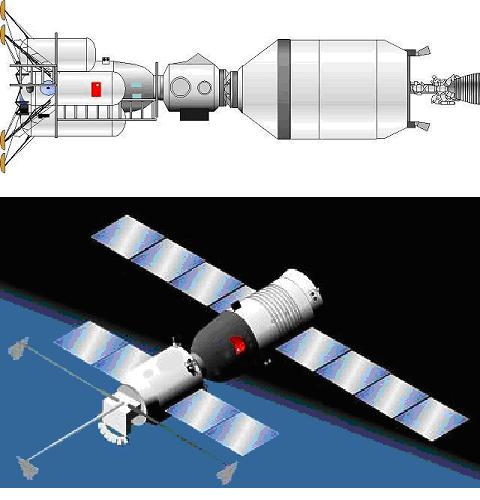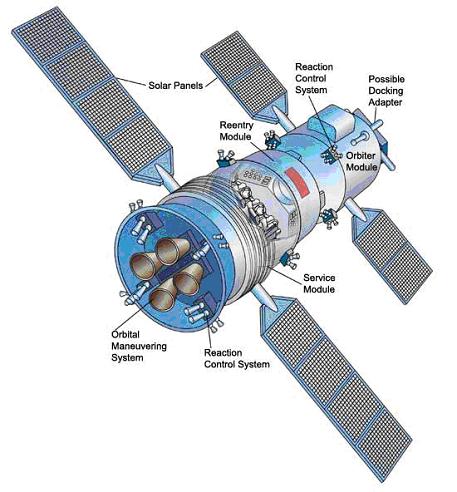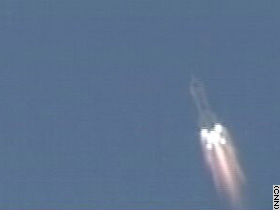Tal Inbar - Israel Space Association www.space.org.il

Above: an approximate illustration showing the Shenzhou spacecraft for landing on the moon * below it - an illustration of the spacecraft in orbit around the Earth
The article was first published in the magazine 'Beyond the Horizon', Issue 6, May 2004.
Direct link to this page: https://www.hayadan.org.il/chiainbar2.html
In the first part of the series we talked about the Chinese spaceships before the manned era.
On the fifteenth of October 2003, the earth shook at the Zhikuan Space Base in China. The powerful engines of the "Long March" launch rocket began their operation, launching El Al China's first manned spacecraft, with the Chinese space pilot Yang Li-wei, on a historic journey into space. About eight minutes later, China became the third country in history (after the USSR and the USA) to send a man into space on its own.
The launch of the spacecraft "Shanzhou 5" (in Chinese - the celestial ship) was the culmination of an ambitious space program, whose roots go back to the early seventies of the twentieth century. China, which has a stockpile of missiles of various types, including intercontinental ballistic missiles and various space launchers, has not hidden its ambitions to integrate into the field of manned space flights as well. Four trial launches of the Chinese spacecraft "Shanzhou" were conducted starting in 1999, without space pilots in it, and after proving the engineering high school and examining the various systems of the spacecraft - it was decided that the fifth flight of this spacecraft would be manned.
The Chinese spacecraft Shenzhou, which at a glance bears a strong resemblance to the old Russian spacecraft "Soyuz", was launched on its first manned mission into low Earth orbit in order to test the various systems of the spacecraft, and establish China's position as a leading country in the field of space. The Chinese space pilot Yang, stayed during the entire mission inside the Earth return chamber, and did not move into the spacecraft's orbital unit. The duration of the flight was 21 hours, during which we enjoyed varied meals of traditional Chinese cuisine. Four surveillance and communication ships scattered across the oceans provided continuous contact with the spacecraft, along with several ground stations. During the flight there was also a live TV broadcast for the enjoyment of Chinese citizens.
With the completion of the last lap, the orbital unit separated from the spacecraft, which continued to circle the earth for six months, while carrying out a series of experiments and military intelligence missions, while the unit intended to return to the earth, containing the Chinese astronaut (the word "takenaut" appeared in the media, but it should be noted that the official designation of China's space pilots is "Yuhang Yuan". In this article I will simply mention "Chinese Astronaut") who began maneuvering for landing.
Illustration showing the Shenzhou 5 spacecraft in orbit around the Earth
The Shenzhou spacecraft is based on the middle of the Russian Soyuz spacecraft, but is larger and heavier than it. A fundamental change is the orbital unit, a cabin where space pilots can stay during the mission. While in the Soyuz spacecraft the cell is small and is not equipped with photovoltaic cells to generate electricity, and at the end of the mission the cell falls into the Earth's atmosphere and burns up, in the Shenzhou spacecraft the cell is much larger, and is intended to remain in space for months. This cell is equipped with its own power supply systems, and at the end of the mission it is an independent satellite. This is a Chinese innovation, and it represents a significant cost savings, since the spacecraft is launched with the orbital unit anyway. In addition to the ability to stay in space for months, the orbital cell is equipped with a connection unit with similar cells, something that can be used to dock spacecraft in space, and also, while utilizing guidance systems from the ground and automation in space, to build a small space station, at a fraction of the cost of the International Space Station.
The launch of the Shenzhou 5 spacecraft - 15.1.0.2003
According to official publications, and during a careful analysis of the structure of the Chinese spacecraft, it appears that the spacecraft relies heavily on the old and proven technology of the Russian "Soyuz" spacecraft. At the same time, the enlargement of the "Shanzhou" spacecraft and the examination of its function - especially when returning to Earth - was carried out by the Chinese without external assistance.
China's intentions in the field of manned space flights were announced even before the "Shanzhou 5" spacecraft was launched, and they include the construction of a space station in orbit around the Earth, the landing of Chinese space pilots on the moon, and even a manned mission to Mars. There is no doubt that this ambitious space program of China - if realized - will place China in a very serious position of power as the main competitor of the USA and the European Space Agency in the field of manned space flights.

A detailed drawing of the Chinese spacecraft Shenzhou. So far this is the most accurate drawing published outside of China showing the spacecraft's systems
The schedule for China's continued manned flights is not precisely defined, but various publications in the Chinese media allow us to estimate that the Shenzhou 6 spacecraft, with two astronauts on board, will probably be launched during the year 2005, for a mission lasting a few days. According to the author of the article, there will be another space flight, of the Shenzhou 7 spacecraft in 2008, on the occasion of the Olympics that will be held this summer in Beijing. It is also possible that in 2008 a model of the Chinese space station will be tested, or a spacecraft meeting of two manned spacecraft.

The first Chinese astronaut - Yang Livi
Official and accurate data on the economic cost of the Chinese manned space program are not available, but estimates speak of a cost of at least one billion dollars, in the development of the Shenzhou spacecraft. There is no doubt that the high costs of developing an infrastructure for manned space flights are not worthwhile solely in order to launch China's national pride into space. It is likely that towards the end of the decade, after carrying out several more successful missions, China will turn to other countries and offer them to launch astronauts into space.
Another possibility, even if it seems remote at the moment, is the integration of China into the International Space Station program. After the Columbia shuttle disaster, and the disabling of the US's ability to launch astronauts into space, Russia remains the only country that transfers supplies and crews to the International Space Station and from there back to Earth.
China can - at least in theory - participate in flights to the International Space Station, in the first stage of delivering supplies, if the partner countries in the station, primarily the USA and Russia, agree to this. Integrating China into the International Space Station will contribute to its safety, and possible help in an emergency. It is understood that such a move will upgrade China's space position in the world, and there will surely be many elements among the global space community who will not want this.
At the same time, the facts speak for themselves - at least until 2005 the US cannot launch astronauts into space by itself - while China can. The integration of China in international projects in the field of space can also be profitable from the economic aspect, since undoubtedly the cost of the Chinese labor force in the field of space (part of which belongs to the Chinese military in general) is immeasurably lower than its counterpart in the USA and Europe.
The modular design of the Shenzhou spacecraft allows for various changes to be made in it depending on the nature of the mission, and it can be estimated that after the decision on manned missions to the moon is made, it will be possible to equip the Shenzhou spacecraft with an additional propulsion assembly (possibly instead of the orbital unit) and routine for the lunar coffee mission.
Launching a Shenzhou spacecraft to the moon will not require the development of a new and powerful launcher, if another spacecraft is launched by the current launch vehicle, including a lunar acceleration stage. This mission will include a rendezvous in orbit around the Earth followed by the injection of the spacecraft into lunar orbit.
Already in 2000, China presented models of a space station and a manned mission to the moon. There is no doubt that China's manned space program will continue and develop, especially in the second decade of the twenty-first century. In China's work plan for the years 2001-2011, there is no budget for a manned mission to the moon, but in light of the statements and plan of US President Bush regarding an American return to the moon by 2015, it is possible that China will change its original schedule and divert budgets towards its lunar program.
In conclusion - China is establishing its position as a space power located in all areas of space activity - development of satellites, launchers, and a manned space program. Today, China is in a suitable starting position to take a leading position in the field of space. It must establish its position in the field of manned flights, and if it is able to develop cooperation with other countries, China will be a major player in the field of space in the second and third decades of the century - exactly at the time when manned space missions to the moon will probably be carried out, and the architecture of a manned mission to Mars will be designed. How China will take advantage of the opportunities open to it - we have to wait and see.
The first part of the review about China's space program
They knew about space operations outside the USA
https://www.hayadan.org.il/BuildaGate4/general2/data_card.php?Cat=~~~887421421~~~200&SiteName=hayadan

